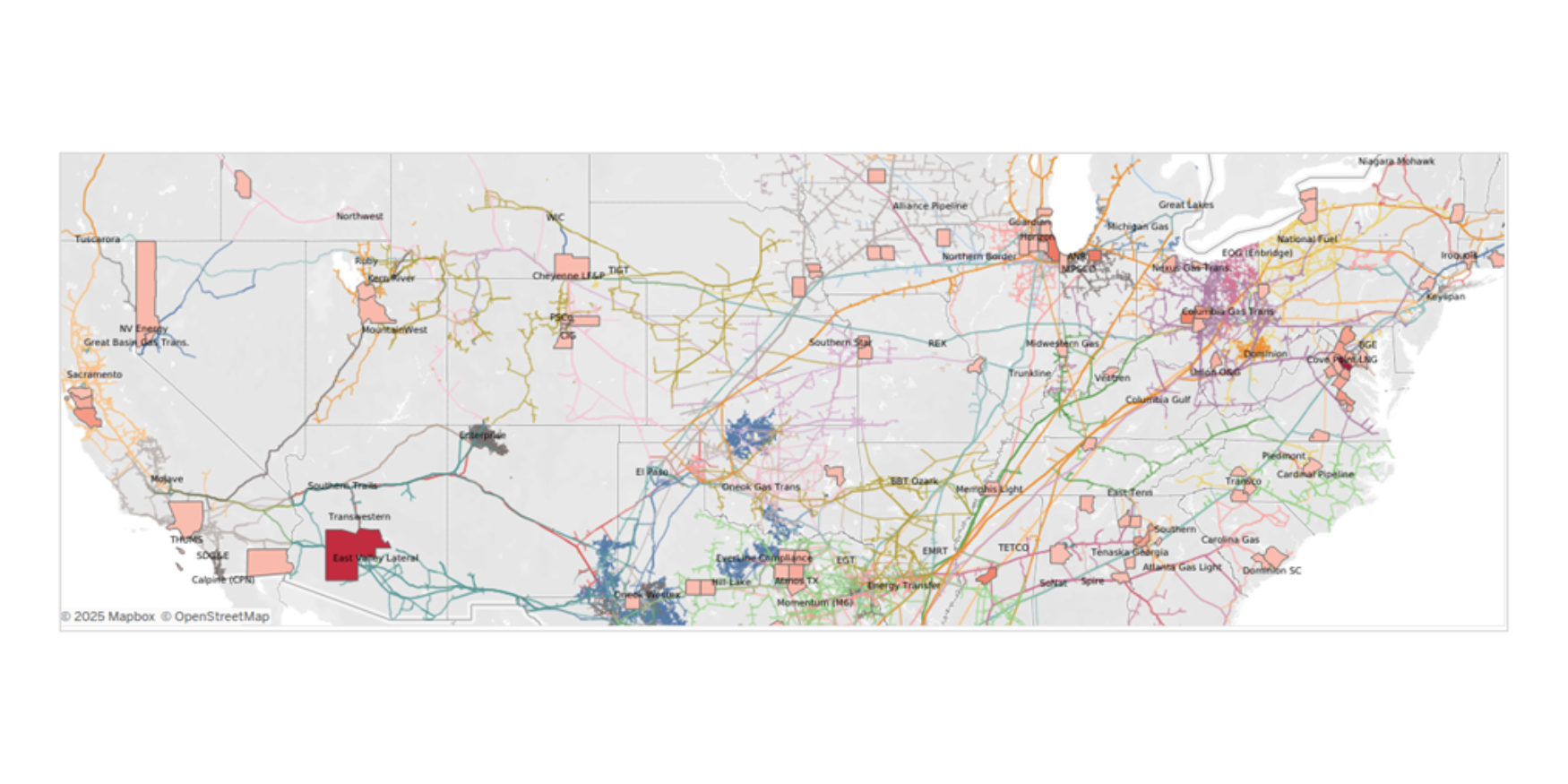The data center industry is growing rapidly and causing a stir in the gas sector in anticipation of surging demand. Yet reality ultimately may not live up to the hype: Advances in AI model efficiency, the emergence of small modular reactors (SMRs), grid interconnection bottlenecks, and improvements in power usage efficiency (PUE) all present risks to upside in gas.
East Daley Analytics last week presented our base case for new gas demand to make electricity for data centers. We forecast 4.2–6.1 Bcf/d of additional demand by 2030, based on 290 projects we track in the new Data Center Demand Monitor (pictured in the image). Momentum is certainly strong for the sector, but there are also reasons for caution. Here we lay out the bear factors for data center demand:
- Increased Computing Efficiency Reduces Power Demand Growth
Advancements in AI model efficiency pose the most immediate risks to demand growth. The week of January 27, DeepSeek made headlines by announcing it had trained an AI model with capabilities comparable to OpenAI’s at 13 times lower cost, implying significantly lower energy consumption. The news sent energy stocks tumbling, reflecting market concerns about how energy efficiency breakthroughs could impact power demand.
Although we do not expect DeepSeek’s innovation to impact capital already deployed for US computing and energy infrastructure, future efficiency gains may reduce the need for hyperscale data centers, thereby lowering total power demand. If AI efficiency trends continue, large-scale facilities powered by natural gas — such as Meta’s Project Sucre, which East Daley estimates will require ~360 MMcf/d of natural gas for onsite generation — could be outliers rather than the future standard.

- Emergence of Small Modular Reactors (SMRs) as a Viable Alternative
The growth of nuclear power, particularly small modular reactors (SMRs) is another risk to natural gas. Google has partnered with Kairos Power, and Oracle has disclosed plans to build data centers powered by SMRs, signaling that major tech firms are actively exploring zero-emission nuclear power as a long-term solution.
While SMRs are not expected to enter service until 2030-35, their viability threatens natural gas’ market share over the long term. Gas infrastructure expansions typically are supported by 15- to 20-year contracts, meaning that developers may hesitate to commit to long-term gas-fired power investments if SMRs become a credible alternative within the next 5 to 10 years.
- Grid Interconnect Bottlenecks Delay Gas-Fired Power Projects
The slow pace of grid interconnection approvals is a structural constraint on gas demand. As of early 2024, ~79 GW of new natural gas-fired generation was waiting for approval in Independent System Operator (ISO) tie-in queues. This number aligns closely with East Daley’s 81 GW data center power demand estimate, but historical data suggests that only ~20% of projects in these queues are actually constructed.
The tech industry is accustomed to rapid innovation, but utility infrastructure and regulatory processes move much slower. This mismatch could delay or limit the number of new gas power plants coming online to serve data centers.
We expect projects will find solutions, such as companies bypassing utilities to build their own generation capacity. One example of such a workaround is Chevron’s partnership with Engine No. 1, which aims to develop up to 4 GW of gas-fired power for data centers. However, unless these private-sector initiatives scale rapidly, infrastructure bottlenecks will continue to stifle project timelines.
- Improvements in Power Usage Efficiency (PUE) Lower Energy Consumption
Increased efficiency in data center operations, specifically reductions in Power Usage Effectiveness (PUE), could dampen demand growth. PUE measures the ratio of total facility power consumption to IT-specific power consumption, with lower values indicating greater efficiency.
East Daley’s base case assumes a PUE of 1.35, meaning that total facility power demand is 35% higher than the IT load alone. However, PUE values reported in data center project announcements have varied widely from 1.1 to 1.6, and ongoing research into cooling and energy optimization continues to drive improvements. If technological advancements reduce average PUE faster than expected, natural gas demand projections could decline meaningfully.
Learn more about East Daley’s data center forecast in the Data Center Demand Monitor, available as part of the Macro Supply & Demand package. This tool gives a bottoms-up approach to monitoring data center projects. We track and map nearly 300 projects by county across the US to visualize where demand could materialize. Reach out to learn more. – Zach Krause.
Data Center Demand Monitor – Available Now!
Introducing Data Center Demand Monitor by East Daley Analytics. This is your go-to source for tracking data center projects and demand. We monitor and visualize nearly 300 US data center projects. Use Data Center Demand Monitor to forecast demand, identify pipeline corridors and track data center projects. — Request your demo now of the Data Center Demand Monitor!
Energy Path – Powered by Energy Data Studio
Introducing Energy Path by East Daley Analytics — a revolutionary tool designed to transform how you view the energy market. With Energy Path, you can seamlessly track the molecule from wellhead to demand, gaining a complete view of the entire oil and gas value chain. From upstream to midstream to downstream, this multi-commodity product offers unparalleled insights across natural gas, NGLs and crude oil. Monitor volumes and fees at every stage, empowering your decision-making with a holistic market perspective.
See energy differently — Request your Energy Path demo now!
The Dirty Little Secrets 2025 Report is Live!
The 2025 Dirty Little Secrets written report is available now. This report goes beyond the webinar discussions to provide a deeper analysis of the topics covered. Learn how commodities are intertwined and identify opportunities for profit from market dislocations. Request a copy of the Dirty Little Secrets report.
The Daley Note
Subscribe to The Daley Note (TDN) for midstream insights delivered daily to your inbox. The Daley Note covers news, commodity prices, security prices and EDA research likely to affect markets in the short term.


